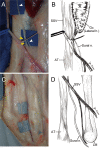Surgical anatomy of the ovine sural nerve for facial nerve regeneration and reconstruction research
- PMID: 31332199
- PMCID: PMC6646377
- DOI: 10.1038/s41598-019-46661-3
Surgical anatomy of the ovine sural nerve for facial nerve regeneration and reconstruction research
Abstract
The lack of a clinically relevant animal models for research in facial nerve reconstruction is challenging. In this study, we investigated the surgical anatomy of the ovine sural nerve as a potential candidate for facial nerve reconstruction, and performed its histological quantitative analysis in comparison to the buccal branch (BB) of the facial nerve using cadaver and anesthetized sheep. The ovine sural nerve descended to the lower leg along the short saphenous vein. The length of the sural nerve was 14.3 ± 0.5 cm. The distance from the posterior edge of the lateral malleolus to the sural nerve was 7.8 ± 1.8 mm. The mean number of myelinated fibers in the sural nerve was significantly lower than that of the BB (2,311 ± 381vs. 5,022 ± 433, respectively. p = 0.003). The number of fascicles in the sural nerve was also significantly lower than in the BB (10.5 ± 1.7 vs. 21.3 ± 2.7, respectively. p = 0.007). The sural nerve was grafted to the BB with end-to-end neurorrhaphy under surgical microscopy in cadaver sheep. The surgical anatomy and the number of fascicles of the ovine sural nerve were similar of those reported in humans. The results suggest that the sural nerve can be successfully used for facial nerve reconstruction research in a clinically relevant ovine model.
Conflict of interest statement
The authors declare no competing interests.
Figures







Similar articles
-
Surgical anatomy of ovine facial and hypoglossal nerves for facial nerve reconstruction and regeneration research: An experimental study in sheep.Microsurgery. 2020 Jan;40(1):51-58. doi: 10.1002/micr.30405. Epub 2019 Jan 21. Microsurgery. 2020. PMID: 30666707
-
Sural nerve harvest: anatomy and technique.J Reconstr Microsurg. 2005 Feb;21(2):133-6. doi: 10.1055/s-2005-864847. J Reconstr Microsurg. 2005. PMID: 15739151
-
Anatomical study of medial and lateral sural cutaneous nerve: implications for innervated distally-based superficial sural artery flap.J Plast Surg Hand Surg. 2012 Feb;46(1):8-12. doi: 10.3109/2000656X.2011.644720. J Plast Surg Hand Surg. 2012. PMID: 22455570
-
Spontaneous trigeminal-facial reinnervation.Arch Otolaryngol Head Neck Surg. 1990 Sep;116(9):1079-81. doi: 10.1001/archotol.1990.01870090095017. Arch Otolaryngol Head Neck Surg. 1990. PMID: 2200443 Review.
-
The bilateral anatomical variation of the sural nerve and a review of relevant literature.Anat Sci Int. 2014 Jan;89(1):57-61. doi: 10.1007/s12565-013-0195-9. Epub 2013 Aug 6. Anat Sci Int. 2014. PMID: 23917949 Review.
Cited by
-
Polyurethane foam for skin graft fixation in clinical-relevant ovine burn wound model for wound repair and regeneration research.Regen Ther. 2020 May 26;14:341-343. doi: 10.1016/j.reth.2020.04.007. eCollection 2020 Jun. Regen Ther. 2020. PMID: 32490059 Free PMC article.
-
Facial nerve regeneration with bioabsorbable collagen conduits filled with collagen filaments: An experimental study.Regen Ther. 2021 Aug 31;18:302-308. doi: 10.1016/j.reth.2021.08.006. eCollection 2021 Dec. Regen Ther. 2021. PMID: 34522722 Free PMC article.
-
Omega-7 oil increases telomerase activity and accelerates healing of grafted burn and donor site wounds.Sci Rep. 2021 Jan 13;11(1):975. doi: 10.1038/s41598-020-79597-0. Sci Rep. 2021. PMID: 33441597 Free PMC article.
-
An electrophysiological evaluation method for the ovine facial nerve.Regen Ther. 2021 Apr 16;18:76-81. doi: 10.1016/j.reth.2021.03.008. eCollection 2021 Dec. Regen Ther. 2021. PMID: 33969162 Free PMC article.
-
Surgical Training on Ex Vivo Ovine Model in Otolaryngology Head and Neck Surgery: A Comprehensive Review.Int J Environ Res Public Health. 2022 Mar 19;19(6):3657. doi: 10.3390/ijerph19063657. Int J Environ Res Public Health. 2022. PMID: 35329354 Free PMC article. Review.
References
Publication types
MeSH terms
LinkOut - more resources
Full Text Sources
Medical

